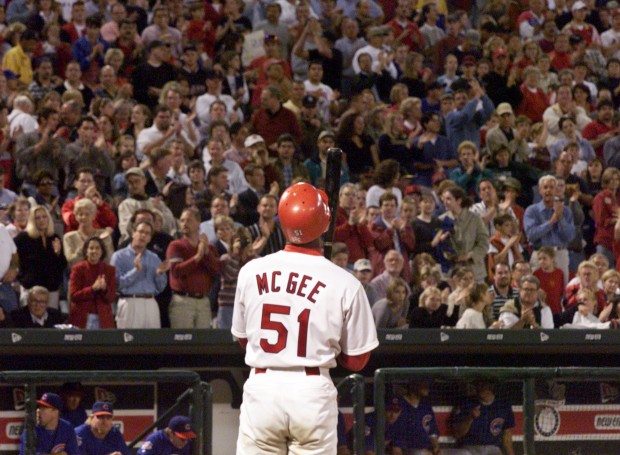(Photo Credit: www.cardinalredbaseball.wordpress.com)
Currently, as of 2016, there are a total of 12 jersey numbers retired by the St. Louis Cardinals’ organization. Also, there are other two honors given to members of the organization that aren’t “retired numbers”. The retired numbers (in order of jersey #):
- Ozzie Smith (#1, retired in 1996)
- Red Schoendienst (#2, retired in 1996)
- Stan Musial (#6, retired in 1963)
- Enos Slaughter (#9, retired in 1996)
- Tony LaRussa (#10, retired in 2012)
- Ken Boyer (#14, retired in 1984)
- Dizzie Dean (#17, retired in 1974)
- Lou Brock (#20, retired in 1989)
- Whitey Herzog (#24, retired in 2010)
- Bruce Sutter/Jackie Robinson (#42, Robinson’s number was retired by all of MLB in 1997, Sutter’s by the Cardinals in 2006).
- Bob Gibson (#45, retired in 1975)
- Gussie Busch (#85, retired in 1984: the number reflects his age at the time)
The other two honored members of the organization:
- Rogers Hornsby (honored in 1937: his number is an “SL” logo instead, as he mostly played during a period without jersey numbers)
- Jack Buck (honored in 2002: his number is a logo of a microphone to honor his broadcasting contributions)
But there is one number that hasn’t been retired, and whether it should be has been a debate for many years.
Number 51. Worn by beloved Cardinal Willie McGee.
From 1982-1990, and 1996-1999, McGee was a familiar face within the Cardinals organization, and a premier player during the innovative style of “Whiteyball” baseball during the 1980’s, a time in which the Cardinals played in three World Series (winning the 1982 World Series).
McGee made his Major League debut on May 10th 1982, but some of his biggest (and most famous) contributions came during the 1982 playoffs. Herzog threw the 23-year old McGee right into the playoffs, and in Game 3 had one of the greatest games in World Series history: he hit two home runs and robbed Gorman Thomas of a home run in the ninth inning, securing the 6-2 victory. The Cardinals won the series in seven games.
Herzog later famously said: ” I don’t know if anyone has ever played a better World Series game than Willie. If he doesn’t make that catch in the ninth, Mr. Sutter’s in trouble.”
In 1984, against the rival Chicago Cubs, McGee hit for the cycle in a game in which he was named the “Player of the Game”.
But his best season came in 1985. During that year, he led MLB with 18 triples, 216 hits, and a batting average of .353, as well as hitting 10 home runs, 82 RBI’s, and stealing 56 bases. That season, he also made the All-Star team, his third Gold Glove Award, the Silver Slugger Award, the NL Batting champion, and National League MVP.
However, the Cardinals fell to the Royals in seven games during the 1985 World Series.
From 1990-1995, McGee had stints with the Athletics, Giants, and Red Sox, before returning to the Cardinals in 1996.
Over the course of his final four seasons, McGee scored 133 runs, garnering 321 hits, 11 home runs, 51 doubles, seven triples, and a total batting average of .279. When he retired at the age of 40, he was the third oldest player in Major League Baseball.
His numbers aren’t Hall of Fame worthy, and it’s unlikely he’d ever be inducted into Cooperstown. However, he has been inducted into the St. Louis Cardinals Hall of Fame, and remains a member of the organization as a Special Assistant.
And for all of his contributions on and off the field, McGee’s number deserves to be retired by the Cardinals.
Buck said it best: “He looks like he doesn’t have a friend in the world. Meanwhile, all the world is his friend.”


